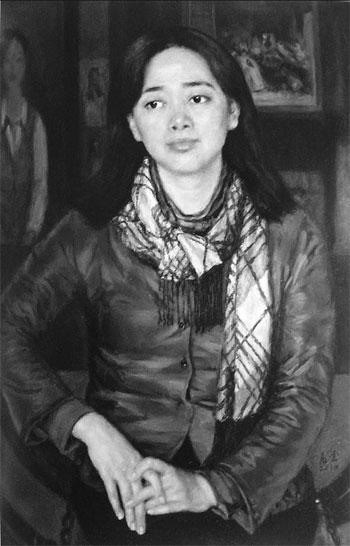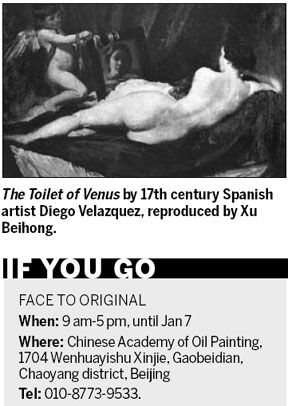

 |
|
Yang Feiyun, curator of the two exhibitions, presents his life painting Woman in Blue. |
Life paintings and reproductions are key to the tradition of oil painting. Track its history in China at an on-going exhibition. Zhang Zixuan reports.
An on-going exhibition at the Chinese Academy of Oil Painting offers a look at China's oil painting history while also exploring the challenges facing this genre. Face to Original, along with another exhibition Paint from Life, that ended on Wednesday at the National Art Museum of China, puts the spotlight on more than 500 life paintings and reproductions of classic masterworks.
The more than 110 artists span three generations: from pioneers such as Xu Beihong and Wu Zuoren, who studied in Europe in the 1930s, and seniors such as Luo Gongliu, Lin Gang and Li Jun, who studied in the former Soviet Union in the 1950s, to contemporary artists such as Chen Danqing, Yang Feiyun and Liu Xiaodong.
"These introspective exhibitions attempt to explore such questions as, 'What changes have occurred from one generation of artists to the other?' and, 'What is the role of life painting and reproductions and do we still need them?"' says Yang Feiyun, dean of the Chinese Academy of Oil Painting and curator of the two exhibitions.
"We have never had a chance to summarize the development of Western painting in China for the past 80 years," says Chen Danqing, realistic artist and co-curator. "The two shows are an attempt to do this and may even throw up a negative picture."
Paint from Life, that included more than 400 portraits, still lifes and landscapes painted from sight, Chen says, was aimed at drawing attention to the mismatch between the huge numbers of artists and students who call themselves realistic painters, and the long absence of life painting.
Since the 1980s, Chen says, the rapid growth of photography and digital image technologies have dramatically changed the way artists see and paint. Some 90 percent of the so-called realistic paintings today, from large-scale creations to small-sized still life practice pieces, are all painted from photos and not the actual objects. Colors too are no longer natural but defined by the processing of prints and photos.
"Painting from still images leads to a loss of sensitivity, which is vital to an artist," Chen explains. "The new painting method might be an opportunity for contemporary art to flourish in the digital age, but it is the end of the road for traditional realism."

Face to Original, on the other hand, focuses on reproductions, which most artists agree are as important as life painting for their artistic development.
A number of exhibited works from more than 20 middle-aged realistic artists were painted this summer, during trips to New York and St. Petersburg organized by Yang, the curator.
For over two months, these artists stood in front of world-famous masterpieces in the art museums of the two cities, and painted for hours.
"We didn't just imitate but reproduced what we saw partly or entirely based on different emphases," says Yang, who contributed seven pieces to the exhibition.
"Only when you go brush by brush can you really discover the truth of those masterpieces with which you thought you were very familiar."
Chen believes the fine imitations created by the first generation artists have themselves become masterpieces, just like Chinese calligraphy.
"In more than 50 years, this is the first time that their reproductions are being exhibited. Many art school students and professors don't even know they exist," Chen says.
"We want to show our respect to them and also bring back a more sincere approach to painting through this exhibition."